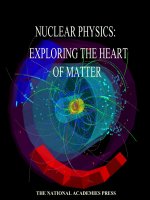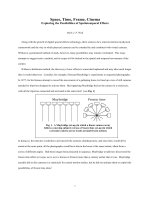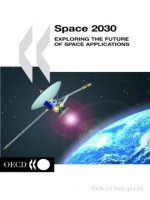4 6 5 exploring the mysteries of space (earth science)
Bạn đang xem bản rút gọn của tài liệu. Xem và tải ngay bản đầy đủ của tài liệu tại đây (5.06 MB, 14 trang )
Suggested levels for Guided Reading, DRA,™
Lexile,® and Reading Recovery™ are provided
in the Pearson Scott Foresman Leveling Guide.
Earth Science
EXPLORING THE
MYSTERIES
OF SPACE
Genre
Expository
nonfiction
Comprehension
Skills and Strategy
• Graphic Sources
• Fact and Opinion
• Monitor and Fix Up
Text Features
•
•
•
•
Captions
Diagram
Labels
Glossary
Scott Foresman Reading Street 4.6.5
ISBN 0-328-13501-1
ì<(sk$m)=bdfab < +^-Ä-U-Ä-U
by Gini Douglass
Reader Response
EXPLORING THE
MYSTERIES
1. Study the diagram of the Copernican solar system
on page 5. Which planets had not yet been
discovered in Copernicus’s day? (You may use a
reference book to help you answer.)
OF SPACE
2. Do you have any questions about a particular
subject that you have just read about? What are
some strategies you could use to find out more
information about this subject?
3. Find the word motion on page 8. Use a dictionary
to find at least two different meanings for the
word. Write sentences to express these different
meanings.
4. Reread page 5. Using a chart similar to the one
below, write astronomers’ names on the left and
their view of the universe on the right.
Astronomer
View
by Gini Douglass
Editorial Offices: Glenview, Illinois • Parsippany, New Jersey • New York, New York
Sales Offices: Needham, Massachusetts • Duluth, Georgia • Glenview, Illinois
Coppell, Texas • Ontario, California • Mesa, Arizona
Every effort has been made to secure permission and provide appropriate credit for
photographic material. The publisher deeply regrets any omission and pledges to
correct errors called to its attention in subsequent editions.
Unless otherwise acknowledged, all photographs are the property of Scott Foresman,
a division of Pearson Education.
Photo locators denoted as follows: Top (T), Center (C), Bottom (B), Left (L), Right (R),
Background (Bkgd)
Opener: Photo Researchers, Inc.; 1 Photo Researchers, Inc.; 3 ©Stone/Getty Images;
5 Corbis; 7 (T) Color-Pic, Inc., (B) Corbis; 9 (T) Library of Congress, (B) Photo
Researchers, Inc.; 10 Roger Ressmeyer/Corbis; 13 (T) NASA, (B) DK Images; 15 (B)
Photo Researchers, Inc., (T) NASA; 16 Photo Researchers, Inc.; 19 (T) NASA, (B) Photo
Researchers, Inc.; 20 (T) Corbis, (B) NASA; 22 NASA; 23 Corbis
ISBN: 0-328-13501-1
Copyright © Pearson Education, Inc.
All Rights Reserved. Printed in the United States of America. This publication is
protected by Copyright, and permission should be obtained from the publisher
prior to any prohibited reproduction, storage in a retrieval system, or transmission
in any form by any means, electronic, mechanical, photocopying, recording, or
likewise. For information regarding permission(s), write to: Permissions Department,
Scott Foresman, 1900 East Lake Avenue, Glenview, Illinois 60025.
2 3 4 5 6 7 8 9 10 V0G1 14 13 12 11 10 09 08 07 06 05
Have you ever gazed up at the night sky and
wondered about the mysteries of the universe? For
instance, do you ever wonder how big the universe is
or what it might be like to travel through space and
see far off stars and galaxies up close? Have you ever
wanted to know exactly how long it would take to
travel to another planet in our solar system? What are
you seeing when you spot a shooting star? If you have
ever found yourself asking such questions, you will be
happy to know that you are not alone. Human beings
have been gazing up at the sky and wondering about
the mysteries of space since the dawn of time.
3
Over the past few thousand years, humans have
been driven by a need to understand and explain the
universe, and this desire to understand the mysteries
of the universe is something that comes naturally to us
all. You may remember being a small child and asking
questions about the way the world works. Perhaps you
saw a bird fly by, and you wondered how that was
possible. Or, perhaps you wondered why the moon
appeared to be round and full on some days, and
shaped like a banana on others. We humans are born
with a deep sense of curiosity about the world around
us, and it is our curiosity that inspires us to learn about
the world in which we live.
Just as we are curious about what lies beyond our
solar system and our galaxy, the Milky Way, early
astronomers had a strong desire to understand what
they were seeing in the sky. Long before technology
was available to assist them, early astronomers were
able to make accurate guesses about the planets and
stars. For example, by observing the positions of the
sun and moon in the sky, early astronomers were
able to create calendars that were very similar to the
calendars we use today, and early astronomers even
took the time to map the position of every visible star
in the night sky.
As early as 280 B.C., a Greek man named Aristarchus
suggested that we live in a heliocentric universe,
with Earth revolving around the sun. Scientists did not
accept his views. If Earth was moving, why couldn’t
they feel it? They believed that the universe was
Earth-centered, or geocentric.
Over time ideas about space changed. As a
result of the work of astronomers such as Nicolaus
Copernicus (1473—1543) from Poland, we came back
to the sun-centered view of the solar system. When
we understood that Earth was not the center of
everything, we saw that the universe was much more
vast and unknown than we had previously imagined.
Venus
Earth
Jupiter
Saturn
Sun
Copernicus (top) believed in a heliocentric
universe. His diagram shows the Sun as
the center of the solar system (bottom).
4
Mercury
Mars
5
As a new view of the universe continued to take
shape, another revolutionary event occurred. In 1608
a man from the Netherlands named Hans Lippershey
invented the first telescope, called a kijker, or
“looker.” Astronomy would never be the same again,
and humanity was on its way to exploring the far
distances of space through a telescopic lens. One of
the first persons to use a telescope to study space was
the Italian astronomer Galileo Galilei. Galileo lived
from 1564 to 1642, and he made several important
discoveries during his lifetime. Galileo was the first to
observe dark spots on the sun called sunspots, and he
observed the craters and peaks that exist on the surface
of the Moon. By using a telescope, Galileo was also
able to prove Copernicus’s claim that the planets in our
solar system revolved around the sun.
As time went on, astronomers used telescopes to
observe space. Astronomers learned more and more
about the planets in our solar system, and our idea
of space began to take on more and more detail. In
1705 Edmond Halley claimed that comets were in
orbit around the sun, and that one in particular would
pass by Earth every seventy-six years. It is now called
Halley’s comet.
6
Halley’s comet (above) and
Edmond Halley (far right)
It turns out that Halley’s comet does exist, and its
orbit has been witnessed by many people throughout
history. Today we know that comets are actually made
up of lumps of ice and dust that travel from the outer
areas of the solar system toward its center, the sun.
When comets get closer to the sun, the heat turns the
ice into steam, and the jets of gas they emit form long
tails that can be seen from Earth. Halley’s comet made
its most recent appearance in 1986, and a number of
countries sent out spacecraft to snap some photos of
the famous comet. The next chance we will have to see
Halley’s comet will be in the year 2062!
7
When you see a streak of light in the night sky it
may appear as if a star is falling toward Earth. What
you are actually seeing is a bit of space debris called
a meteoroid. It is believed that meteoroids are formed
when asteroids collide in space. Asteroids are made
of rock or metal, and they orbit the sun in a region
between Mars and Jupiter called the Asteroid Belt.
Italian astronomer Giuseppe Piazzi discovered the first
minor planet, or asteroid, called Ceres, in 1801. It was
estimated to be 930 km (578 miles) in diameter, which
is about the same size as Texas!
The 1800s was an exciting time in the history of
astronomy. At this time, astronomers were learning
more about the planets and their orbits, or revolutions
around the sun, and beginning to understand more
about the universe in the process. For example, in
1846, the eighth planet from the sun, Neptune, was
discovered.
Scientists figured out that, according to Newton’s
laws of motion, there was something not quite right
about the orbit of Uranus, the seventh planet from
the sun. Scientists predicted that another planet, now
called Neptune, might exist beyond Uranus, which
would explain the disturbance of Uranus’s orbit. They
were right.
Neptune was actually observed in 1612 by Galileo.
Galileo observed Neptune, but he concluded that the
enormous blue object was a star rather than a planet.
During the few days that Galileo had the opportunity
to observe Neptune, he noticed that its position
seemed to change slightly. Ordinarily, this might have
suggested to him that what he observed was something
other than a star, but unfortunately, Neptune slipped
out of his view before he could determine that it was
indeed a planet and not a star. Of course, we now
know that there is only one star in our solar system:
the sun.
The mathematician and physicist Isaac
Newton (top) described how and why
objects move in his three rules known
as Newton’s laws of motion. His work
helped scientists discover the planet
Neptune (bottom).
8
9
The case of Galileo’s near discovery of a new planet
shows how much our understanding of the solar
system and outer space has changed in only a few
centuries. In fact, astronomers at the beginning of the
1900s were not aware that any galaxies beyond our
own galaxy, the Milky Way galaxy, existed.
This is the W. M. Keck
Observatory in Hawaii
(left) and an interior
view of its telescope
(below).
10
Astronomers began to notice what looked like
cloudy patches of distant stars, and they concluded
that these patches were part of the Milky Way galaxy.
In the 1920s a man named Edwin Hubble studied these
same patches of stars, and he realized that he was, in
fact, observing other galaxies!
Astronomers and scientists in the 1900s continued
to observe and study the mysteries of space. These
scientists used powerful telescopes to search for far-off
planets and stars, and they also began to understand
that new forms of space exploration were possible.
Soon, they began to develop the technology that
would make space exploration a reality.
The technological advances of the 1900s brought
about a new effort to explore deep into space, and
modern space exploration took on a whole new
dimension. Up until that time period, our exploration
of space was limited to what we could observe from
Earth. Though we learned a great deal about space
from what we observed through powerful modern
telescopes, scientists and astronomers knew that
we could learn even more by traveling through
space itself. If we could find a way to get beyond
Earth’s atmosphere, then we could gain a whole new
perspective of our solar system and outer space.
11
It soon became evident that rockets were the secret
to making space exploration possible. As early as
A.D. 1045, the Chinese had used rockets for military
purposes. A Russian scientist named Konstantin
Tsiolkovsky, who lived in the mid-1800s to early 1900s,
had made important discoveries regarding rocket
science and space flight. Tsiolkovsky’s discoveries were
essential to our understanding of how rockets could be
used to launch space ships.
In 1919 an American scientist named Robert
Goddard began to experiment with rockets. Goddard
was the first to suggest that a rocket could one day
reach the moon. Many people made fun of Goddard
and his ideas, but history would soon prove that his
ideas were not so crazy after all.
Goddard worked with the U.S. government
during World War II, using the rocket technology he
developed to aid in the war effort. At the same time,
scientists in other countries worked to develop their
own programs in rocket science. In 1957 the Soviet
Union (now called Russia) launched the world’s first
man-made satellite, Sputnik 1, into orbit around
Earth. A few months later, the United States launched
its own satellite, Explorer 1, into space.
12
NASA was created partly in
response to the successful launch
of Sputnik 1 (above) and the
Russian space program.
In 1958 a very important, government-sponsored
organization called the National Aeronautics and
Space Administration (NASA) came into being. NASA
became the center of technological and scientific
research for the American space program and remains
its headquarters today. NASA was established, in part,
in response to the successful launch of the satellite
Sputnik 1 by the Soviet Union. In the years following
World War II, the governments of the United States
and the Soviet Union did not have a good relationship,
and the two countries each lived in fear that the other
would move ahead in the race to explore space.
13
Although relations were not very good, the
competition between the Soviet Union and the United
States inspired each country to make great progress
in space exploration. Achieving human space travel
became a priority for both nations, and NASA’s goal
was to make human space travel a reality. Just twelve
years after the launch of Sputnik 1, the United States
sent astronauts to the moon.
The United States and Soviet Union continued
to launch more satellites and robotic aircraft into
space, and the dream of sending a human being into
space would soon become a reality. Before this could
be accomplished, however, it was important that
unmanned missions collect as much information as
possible about the conditions humans would face
during space travel.
Unmanned missions into space have brought back
crucial information that allowed us to prepare for
human space flight. Sending an unmanned aircraft or
satellite into space has many benefits. Unmanned (or
robotic) spacecraft and satellites can go farther into
space and can remain in space for longer periods than
spacecraft carrying humans. Also, since there is no
need to worry about supporting and protecting human
life, the level of risk is much lower.
14
Unmanned aircraft and satellites were very
important to both space programs at the time, and
they continue to be essential to space programs today.
For instance, even though the technology we have
created has allowed us to travel to the moon, we are
still unable to travel to the surface of the planet Mars.
For human beings, the trip still would be too risky.
Our technology has not caught up with our dream to
visit another planet in person, which is why robotic
missions are so important.
A Mars Rover collects
information and takes photos
of the red planet’s surface.
15
Over the past four decades, other important
unmanned space missions have brought back
astonishing pictures of the distant places in our solar
system and beyond. The Hubble Space Telescope,
named after the astronomer Edwin Hubble, was
launched into space in 1990. NASA and the European
Space Agency (ESA) created and designed the Hubble
together. The Hubble Telescope is actually a floating
observatory, orbiting Earth at the rate of five miles per
second. It takes the Hubble telescope only ninety-six
minutes to make one complete orbit of Earth.
These images of nebulae were
photographed by the Hubble.
16
The satellite Galileo, which was launched into space
in 1989 by the space shuttle Atlantis, provided us with
more evidence that our solar system is a mysterious
and enchanting place. Galileo’s mission was to travel
to the planet Jupiter. Once it arrived, after traveling
more than six years, the satellite collected data about
Jupiter and some of its moons. It was hoped that
Galileo’s mission would last for about two years, but
the hardworking satellite ended up sticking around for
eight! As a result of Galileo’s mission, we were able to
learn more information than ever before about Jupiter’s
atmosphere and about some of Jupiter’s moons.
Unmanned missions into space continue to be an
essential aspect of our space program, and scientists are
currently hard at work designing new spacecraft and
planning new missions that will stretch the boundaries
of our imaginations even further. These unmanned
missions have taught us that we are but a small piece of
the puzzle that is the universe.
Nevertheless, what we lack in size, we make up
for in spirit. The information we have learned about
our universe at each step of our space program has
motivated us to continue our exploration, and human
space travel has been, perhaps, the most dramatic and
inspiring form of space exploration to date.
17
Many people have volunteered to take the giant
leap into outer space. It all began in 1961, four years
after the Soviet launch of Sputnik 1. The first person
to travel to outer space was a Russian man named Yuri
Gagarin. Gagarin orbited Earth once in a spacecraft
called the Vostok 1, and his flight lasted one hour and
twenty-nine minutes. Today, astronauts are able to stay
in space for much longer, but back in 1961, Gagarin’s
mission was nothing short of miraculous.
After Yuri Gagarin’s trip, an American astronaut
named Alan B. Shepard, Jr., became the second human
being, and the first American, to orbit Earth. Following
these two moments in space history, the race between
the Soviet Union and the United States intensified.
While the Soviet Union seemed to be more interested
in doing scientific research in space, the United States
was determined to send the first human being to
the moon. This became the main focus of our space
program, and a matter of national interest.
In 1961 President John F. Kennedy challenged the
American people to put a man on the moon by the end
of the decade. Kennedy inspired the nation, especially
the many dedicated people at NASA who worked,
through trial and error, to make this dream a reality.
18
The Apollo 11 crew (right)
and the first steps on the
moon (above)
In 1967 NASA began a series of missions into space
called the Apollo missions. In 1969, after learning as
much as possible about how to travel safely on the
moon, NASA launched the Apollo 11 mission. On
July 20, astronauts Neil A. Armstrong and Edwin
E. Aldrin, Jr., landed safely on the moon’s surface
in a lunar module designed to carry them to their
destination. Millions of people back on Earth watched
the incredible events unfold on TV.
19
It has been called one of the most important
moments in human history. Armstrong, commander
of the Apollo 11 mission, became the first man to walk
on the moon. His words upon setting foot on the lunar
surface were, “That’s one small step for man, one giant
leap for mankind.” Today, Armstrong’s words remain as
unforgettable as the triumphant success of the Apollo
11 mission.
Armstrong and Aldrin’s visit to the moon lasted a
little longer than two hours, but the effect of their visit
on the imagination of the American people and the
world would last much longer. Following the success of
the Apollo 11 mission, we continued to strive to reach
new heights in space.
American and Russian
astronauts (left) train for
life aboard the ISS (right).
20
Human space exploration is still a relatively new
enterprise, but it is amazing to consider the progress
we have made. We must pay tribute to the many brave
astronauts who have risked their own safety so that
humankind could benefit from their brilliant work in
space. Today, human space exploration has become
a truly international effort, and people from many
different countries have contributed their ideas and
knowledge to the cause of space exploration.
Russia and the United States, along with fourteen
other countries, are working together to complete the
International Space Station (ISS). The International
Space Station is large enough for astronauts to live
and work inside it. The first piece of the station was
launched in November of 1998, and since then many
sections have been added to it—it is currently the length
of three school buses. By the time it is completed, it
will be about the length of a football field. Scientists
hope that their work at the ISS will bring us closer to
our goal of visiting and living on a planet such as Mars.
Human beings have never stopped striving to learn
more and more about our place in the universe. The more
we learn, the more we realize how much is still unknown
to us. People once believed that the planet Earth was the
center of the universe, but we now understand that it is a
tiny part of a vast universe yet to be explored.
21
Now Try This
Lead a Mission to the International Space Station
Now it’s your turn to go on a mission into space—a
mission of the imagination. At this very moment on
the International Space Station, a crew of astronauts
is hard at work conducting experiments and helping
with its construction. By the time construction on the
Space Station is completed, it will have taken forty-five
missions to get the job done.
Several crews on many different missions have
already traveled to the International Space Station to
contribute their skills toward its completion. Teamwork
has been the key to making these missions possible. If
you could be the commander of the next mission to
the International Space Station, what would you like to
say to your crew? Why not start by writing a letter of
welcome!
22
to Do It!
w
o
H
s
’
e
r
He
1. First, before you sit down to write your letter of
welcome, you may want to take some time to
brainstorm. What are the most important points
you want to make?
2. You may want to mention some important
moments in the history of space exploration in
order to inspire your crew. Think about some of the
exciting discoveries and missions that have taken
place in the past. What do you think was the most
inspiring moment in space exploration history?
3. You may want to thank your crew for joining you
on this mission, and congratulate them on their
success as astronauts. Be sure to tell them how
much you will appreciate their hard work.
4. As you may know, space missions always have
powerful and memorable names. Some of the earlier
space missions have had names such as Mercury,
Apollo, and Endeavor. If you could choose an
inspiring name for your mission, what would it be?
How will this name reflect the goals of your mission
to work at the International Space Station?
23
Glossary
astronomers n. experts
in the science that deals
with the sun, moon,
planets, stars, etc.
data n. facts from which
conclusions can be
drawn; things known or
admitted; information.
debris n. scattered
fragments; ruins;
rubbish.
galaxy n. a group of
billions of stars forming
one system.
Reader Response
geocentric adj. viewed
or measured from
Earth’s center.
heliocentric adj. with
the sun at the center.
satellite n. an
astronomical object
that revolves around a
planet; a moon.
1. Study the diagram of the Copernican solar system
on page 5. Which planets had not yet been
discovered in Copernicus’s day? (You may use a
reference book to help you answer.)
2. Do you have any questions about a particular
subject that you have just read about? What are
some strategies you could use to find out more
information about this subject?
3. Find the word motion on page 8. Use a dictionary
to find at least two different meanings for the
word. Write sentences to express these different
meanings.
4. Reread page 5. Using a chart similar to the one
below, write astronomers’ names on the left and
their view of the universe on the right.
Astronomer
24
View









